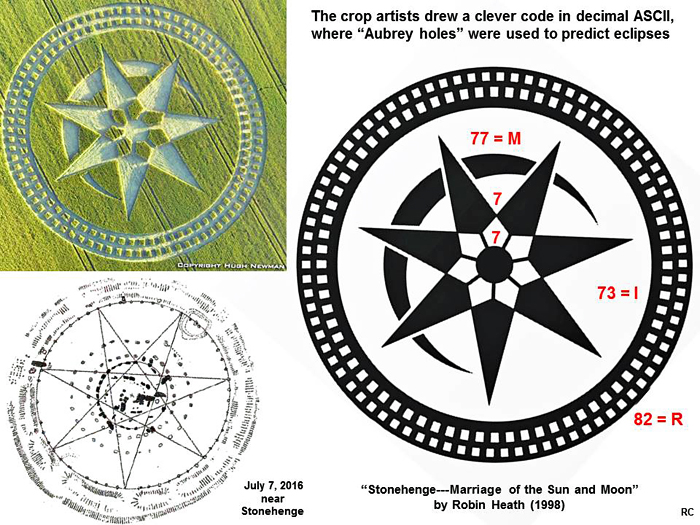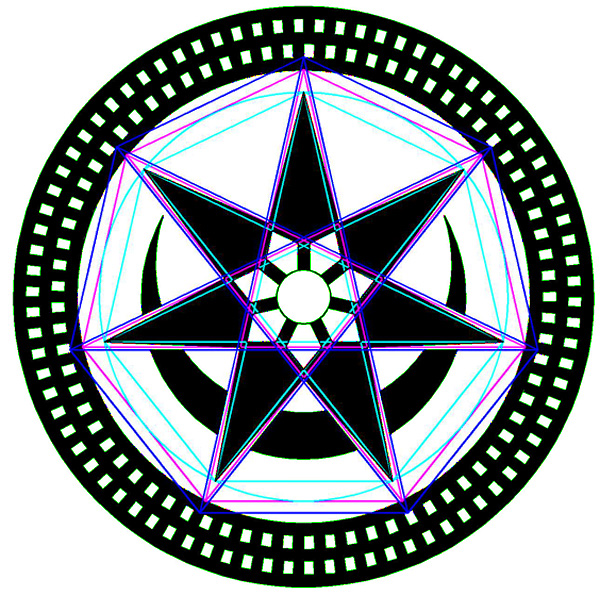|
The
construction, geography and astronomy of English megalithic sites: why
did those mysterious “crop artists” draw a “seven-pointed star” in a
field across from Stonehenge on July 7-8, 2016?
A new and
remarkable crop picture appeared in a field across the road from
Stonehenge in southern England, apparently on the night of July 7-8,
2016. An aerial photograph of this wonderful crop picture is shown at
upper left in the slide below:

At lower
left, we can see a matching “explanatory diagram” for the construction
of Stonehenge nearby. This diagram has seven-fold symmetry, and features
a seven-pointed star. It was taken from an article entitled
“Stonehenge: Marriage of the Sun and Moon” by Robin Heath
(see
cura.free.f).
On the
right-hand side of this slide, we show a black-and-white sketch of the
new crop picture. Right away we can see a good fit to Heath’s
explanatory diagram, since both images contain large “seven-pointed
stars”. There is also a good fit to a small “seven-pointed star” near
the centre. Those two “stars” are staggered by 1/14 of a circle relative
to one another.
Clearly one
message from this new crop picture seems to be: “a seven-pointed star
was used in the construction of Stonehenge long ago”.
This crop
picture in addition shows a clever code or message in its outer parts.
They seem to read “M-I-R”
in decimal ASCII. That is a word which means “world” or
“peace” in Russian. This clever and subtle code will be explained
further below.
Did the
builders of Stonehenge use a “seven-pointed star” during certain phases
of construction long ago?
An
independent analysis by Professor David Gregg has likewise suggested
that a “seven-pointed star” was used, during one phase of the
construction of Stonehenge in ancient times (see
DavidGregg ).
By studying his diagram, we can see how 56 “Aubrey holes” around the
outside may be divided into seven equal parts. Such a division creates
the impression of seven-fold symmetry. Those “Aubrey holes” were used to
predict solar or lunar eclipses (see
stonehenge eclipses). If we trace the path of that “seven-pointed
star” in towards the centre, we find that an inner “Sarsen circle” of
stones was placed exactly where any two “arms” of the “seven-pointed
star” first intersect.
The
schematic diagrams of Stonehenge as made by other authors also show a
good fit to this new crop picture. For example, a crescent-shaped series
of “trilithons” near its centre (see
old-plans-of-stonehenge) match a large “crescent” shape in the crop
picture, which was drawn “under” its large “seven-pointed star”. The
“crescent” shape in this crop picture was oriented precisely in the
field, so as to match a crescent-shaped outer border for Stonehenge
nearby (please see long-range aerial photographs on
stonehenge 2016).
Furthermore,
in most of these explanatory diagrams, as made by any author, we can see
two rings of small, rectangular standing stones around the outside,
which match “two borders” of “small squares” as drawn in crops. For
example a series of “small dots” or thin serrated lines, around the
outside of Heath’s explanatory diagram, just beyond the “points” of his
large “seven-pointed star”, seem to resemble two outer borders of “small
squares” in the new crop picture. What might this mean?
A clever
code around the outside, where “Aubrey holes” were once used to predict
eclipses
Long ago at
Stonehenge, its outer border consisted of 7 x 8 = 56 “Aubrey holes”,
which were used to predict solar or lunar eclipses. In the new crop
picture, we can count 73 or 82 “small squares” in a corresponding
location, within its first or second “outer borders” respectively.
Why did
those crop artists change the number of “small squares” along the
outside, from 56 to 73 or 82? Quite plausibly, they may have been trying
to provide us with a message in decimal ASCII code, by a scheme which
was used in other crop pictures from the past, for example at Poirino,
Italy on June 20, 2010 (see
time2012bl).
The
geometric “numbers” in this new crop picture seem to read
“7-7”
(for July 7), then “73”
and “82”, when
going from its centre to its outer parts. If such numbers are regarded
as “letters” in decimal ASCII (see
www.asciitable.com), then we find a three-letter word
“M-I-R”
which means “world” or “peace” in Russian. Any interested reader
may study the details of such coding in a slide posted above.
Are they
predicting “MIR” as “world peace”?
Perhaps
those crop artists are trying to tell us that they can predict, not only
“eclipses” like at Stonehenge, but also a possibility for “MIR” or
“world peace”? In these troubled times on Earth?
The “lunar
crescent” from this crop picture pointed toward an intersection of two
roads nearby, rather than towards Stonehenge itself. Also, this crop
picture appeared on a date when a crescent Moon was about to intersect
(or conjunct) with Jupiter in Earth’s night sky. This might be regarded
as a kind of “eclipse”.
Sevens and
more sevens: the geography and astronomy of English megalithic sites
How does a
number “7” enter into the geography or astronomy of
English megalithic sites? We can study Robin Heath’s article to learn
more (see
cura.free.fr).
First,
Avebury Ring was constructed at latitude (360o / 7) = 51.4286o
N, which equals precisely one-seventh of a planetary
circle.
“So
exact is this figure, that I suggest it was no accident or coincidence.
The ancient builders of Avebury had a technique to calculate latitude to
within seconds of a degree.”
The
latitude of Stonehenge at 51.1789o is just one-quarter
(0.2497o) of a degree away from one-seventh of a planetary
circle (51.4286o).
Also at
Stonehenge, the location of a rising Sun on the northeast horizon is
approximately one-seventh (51o) of a circle
away from due North, on the summer solstice of June 20 or 21. It was
marked there by a “Heel Stone” (see
gallery-the-summer-solstice-as-seen-from-stonehenge).
Finally at
Stonehenge, its inner “Sarsen circle” (just outside of a crescent-shaped
ring of “trilithons”) may have once been constructed, by drawing a
seven-pointed star from the outer “Aubrey holes” in towards
its centre (see
cura.free.fr):
“This
Sarsen circle may have been located precisely, by drawing a ‘seven-sided
star’ from an outer Aubrey circle in towards its centre. The seven
‘arms’ of such a ‘star’ cross at 100.8 feet from the centre, which is
the mean diameter of the Sarsen circle.”
For all of
these reasons, it makes good sense for those mysterious crop artists to
have drawn a “seven-pointed star” next to Stonehenge on July 7, 2016.
They confirmed for us how Stonehenge was once built, and they conveyed a
message of “MIR” or “world peace”. Many modern people have lost the
knowledge once possessed by their ancestors. This is why they cannot
easily understand. If they read the new information presented here,
perhaps some of them may understand then?
Red Collie
(Dr. Horace
R. Drew)
P.S. We
would like to thank Robin Heath and David Gregg for their excellent
research into the astronomy and geography of English megalithic sites,
and Hugh Newman for his aerial and ground photographs of the new crop
picture.
P.S.S. The
mathematician Amber Wing sent me this colourful diagram, which shows
“seven-fold symmetry” within the new crop picture, at a series of
different geometrical locations:

|